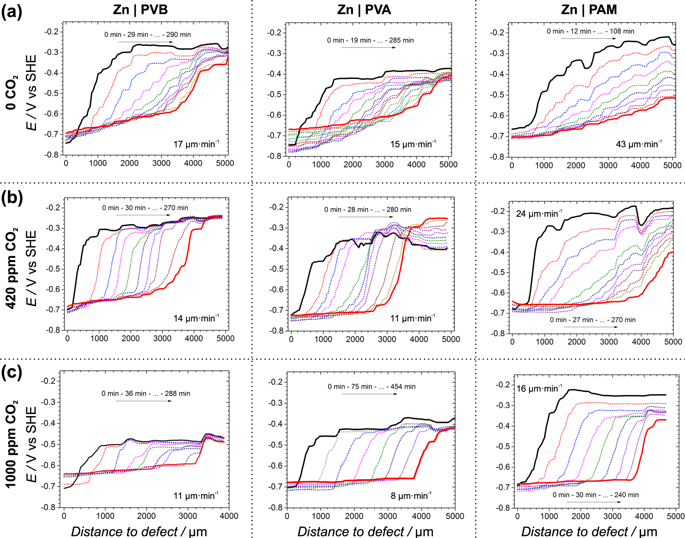npj Materials Degradation ( IF 5.1 ) Pub Date : 2019-01-07 , DOI: 10.1038/s41529-018-0064-z Viacheslav Shkirskiy , Matthias Uebel , Alina Maltseva , Grégory Lefèvre , Polina Volovitch , Michael Rohwerder

|
The degradation of the Zn|polymer interface is inhibited by CO2 gas in a humid environment. The inhibition mechanism varies greatly for different polymer matrices and depends on the affinity of the polymer to CO2. Coatings based on polymers with high affinity to CO2 such as polyacrylamide show high delamination rates due to the fast uptake of water. In this case, the cation transport that causes the initial pull down of potential for initiating the oxygen reduction reaction occurs via the polymer. Here CO2 decreases water uptake due to competitive absorption into the polymer matrix, inhibiting the delamination rate. CO2 can quickly reach the interface of polymers with functional groups with a low affinity to water and CO2, such as polyvinyl butyral and polyvinyl alcohol. In this case, the inhibition of the delamination rate is achieved by a strong decrease in cation migration rate at the Zn|polymer interface accompanied by the formation of mixed hydrozincite/absorbed CO2 layers on the ZnO surface underneath the polymers. Further experiments showed that the presence of CO2 accelerates anion migration, suggesting an influence of CO2 on the surface charge at the Zn|coating interface, thus affecting ion migration. Inhibition of cation migration has never been reported before and should be taken into account into the mechanism of cathodic-driven delamination on Zn under atmospheric conditions.
中文翻译:

通过抑制阳离子沿大气中CO 2沿Zn |聚合物界面的迁移,抑制了阴极驱动涂层的分层
潮湿环境中的CO 2气体可抑制Zn |聚合物界面的降解。对于不同的聚合物基质,抑制机理变化很大,并且取决于聚合物对CO 2的亲和力。基于对CO 2具有高亲和力的聚合物(如聚丙烯酰胺)的涂料由于水的快速吸收而显示出高的分层速率。在这种情况下,经由聚合物发生引起初始引发氧还原反应的电位下降的阳离子传输。在此,由于竞争性吸收到聚合物基质中,CO 2减少了水的吸收,从而抑制了分层速度。一氧化碳2可以迅速到达具有对水和CO 2的亲和力低的官能团的聚合物的界面,例如聚乙烯醇缩丁醛和聚乙烯醇。在这种情况下,通过在聚合物界面下方的ZnO表面上形成混合的水锌矿/吸收的CO 2层,同时在Zn |界面处的阳离子迁移速率大大降低,从而实现了对层离速率的抑制。进一步的实验表明,CO 2的存在加速了阴离子的迁移,提示了CO 2的影响Zn |界面上的表面电荷会因此而受影响,从而影响离子迁移。以前没有关于抑制阳离子迁移的报道,应该将其考虑到在大气条件下阴极驱动的锌脱层机理中。


























 京公网安备 11010802027423号
京公网安备 11010802027423号